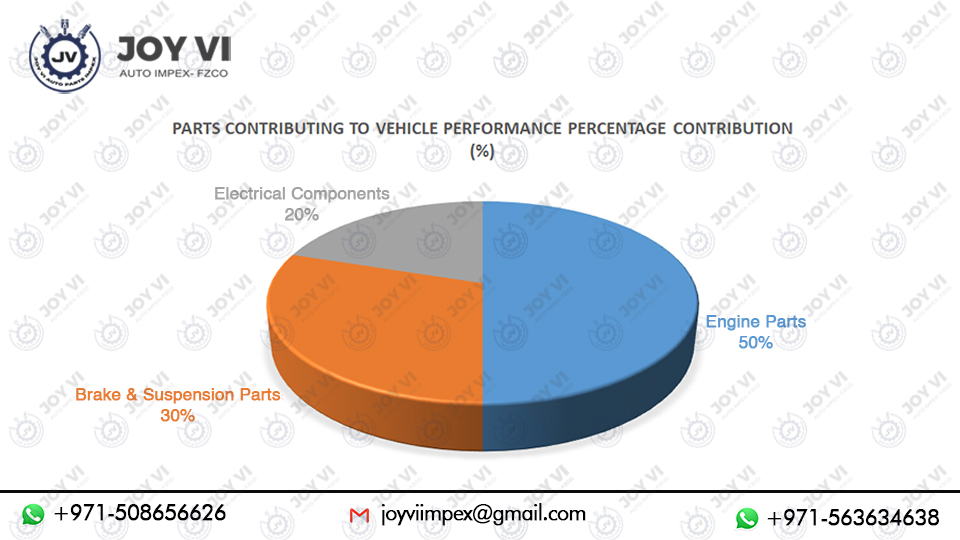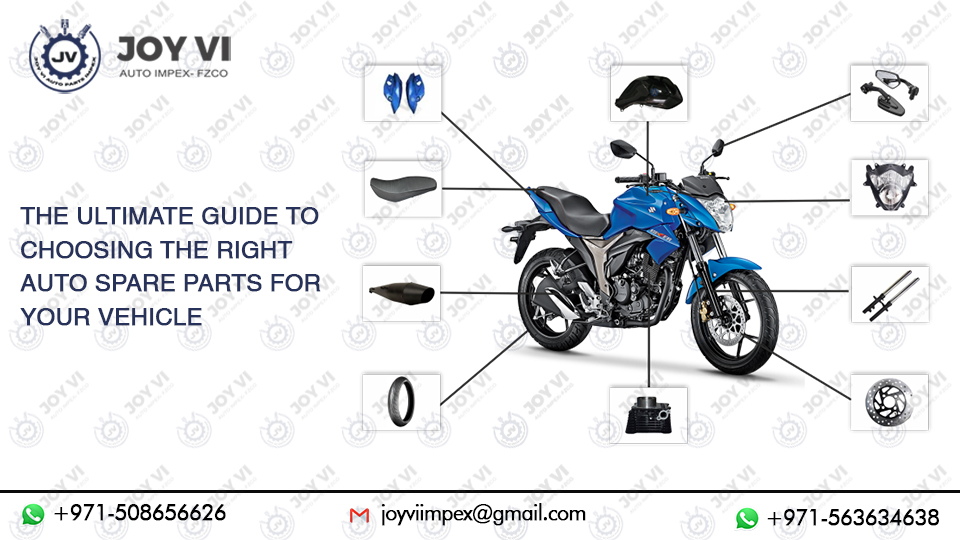Choosing the right auto spare parts is essential for maintaining your vehicle’s performance, safety, and longevity. This guide will take you through the most important aspects, including types of parts, how to identify quality, and tips for buying them online. Let’s dive in, adding research-backed insights, data, and visuals to help make the best decision for your vehicle.
Understanding the Different Types of Auto Spare Parts
Auto spare parts can be categorized into three primary types: OEM (Original Equipment Manufacturer) parts, aftermarket parts, and used parts.
Comparison of Auto Spare Part Types
|
Part Type |
Description |
Advantages |
Disadvantages |
|
OEM Parts |
Parts made by the vehicle manufacturer. |
Perfect fit, high quality, comes with warranty |
More expensive |
|
Aftermarket |
Parts made by third-party companies. |
Often cheaper, wide variety of options |
Quality and fit can vary widely |
|
Used Parts |
Pre-owned parts that have been removed from vehicles. |
Cost-effective solution |
May come with wear and tear, no warranty |
Price vs. Longevity of Auto Parts
|
Part Type |
Longevity (Years) |
|
Average Cost (USD) |
|
OEM Parts |
10 |
|
250 |
|
Aftermarket Parts |
8 |
|
150 |

Graph of Price vs. Longevity of Auto Parts
Explanation:
- OEM Parts: These parts typically last around 10 years but come with a higher price tag, ranging between $200 and $500.
- Aftermarket Parts: Offering a middle ground, aftermarket parts last about 8 years and are more affordable, generally costing between $100 and $300.
- Used Parts: Although they are the most cost-effective, used parts have a shorter lifespan of around 4 years and cost between $50 and $150.
How to Identify Quality Spare Parts for Your Vehicle
To ensure you’re getting quality spare parts, consider these key factors:
- Certifications: Parts that meet industry standards (e.g., ISO certification) tend to be more reliable.
- Brand Reputation: Trusted brands with positive reviews are more likely to offer durable parts.
- Material Quality: Ensure the parts are made from high-quality materials that can withstand wear and tear.
Table: Comparison of Common Certification Standards
|
Certification Standard |
What it Ensures |
Examples |
|
ISO Certification |
Ensures consistency in product quality. |
OEM and high-end aftermarket parts |
|
SAE Standards |
Ensures automotive parts meet safety and performance benchmarks. |
Brake pads, tires, electrical components |
|
TS16949 Certification |
Focuses on production quality for automotive components. |
Transmission and engine parts |
The Importance of Compatibility: Ensuring the Right Fit
-
Common Compatibility Issues Across Different Vehicle Brands
Vehicle Brand Common Compatibility Issue Explanation Toyota Incompatible brake rotor sizes Aftermarket brake rotors may vary in size, leading to poor braking performance and safety risks. Ford Incorrect fitment of electrical components Generic electrical parts may not match the specific connectors, resulting in malfunctioning systems. Honda Mismatched exhaust components Poorly fitting exhaust parts can cause leaks, reducing engine efficiency and increasing noise levels. Chevrolet Misalignment of suspension components Non-OEM suspension parts may not align properly, leading to handling issues and increased tire wear. Nissan Loose-fitting air filters Generic air filters may not create a proper seal, allowing dirt to enter the engine and cause damage. Volkswagen Incorrect transmission fluid compatibility Using the wrong transmission fluid can lead to shifting issues and damage to the transmission system. Subaru Improper fitment of timing belt Aftermarket timing belts may not meet OEM specifications, risking engine failure if they don’t fit correctly. Hyundai Mismatched body parts Generic body panels may not fit snugly, leading to moisture ingress and potential rust issues.
Explanation of Compatibility Issues:
- Toyota: Incompatible brake rotors can lead to inadequate braking power, potentially causing accidents.
- Ford: Electrical components that don’t match can lead to faulty connections, making critical systems unreliable.
- Honda: Mismatched exhaust parts can affect engine performance and result in excessive emissions.
- Chevrolet: Misalignment in suspension parts can cause handling problems and decrease ride comfort.
- Nissan: Loose air filters may allow contaminants to enter the engine, leading to increased wear and tear.
- Volkswagen: Incorrect transmission fluid can cause shifting problems and damage transmission components over time.
- Subaru: An improperly fitted timing belt can lead to serious engine damage if it fails.
- Hyundai: Generic body panels may not seal properly, leading to rust and damage over time.
Conclusion:
Understanding compatibility is essential when choosing auto parts for your vehicle. Always refer to your vehicle’s manual or consult with a professional to ensure that the parts you select are designed specifically for your make and model. This diligence can save you from performance issues, safety hazards, and costly repairs in the long run.
Tips for Buying Auto Spare Parts Online Safely
Research Findings: Online Purchase Safety
When shopping online, it’s crucial to ensure that you’re dealing with reputable sellers. According to research by the Better Business Bureau (BBB), counterfeit auto parts are becoming increasingly prevalent on certain online platforms, which can lead to safety risks and performance issues.
Steps to Stay Safe When Buying Online:
- Check the Seller’s Reputation: Look for reviews and ratings.
- Use Secure Payment Methods: Ensure the site uses SSL encryption for secure payments.
- Verify the Return Policy: Make sure you can return parts if they don’t fit.
- Compare Prices: Avoid deals that seem “too good to be true.”
Frequency of Auto Parts Fraud on Different Platforms
|
Platform Type |
Auto Parts Fraud Cases (per year) |
|
Unknown/Untrusted Sites |
70 |
|
Known Marketplace Sites |
50 |
|
Trusted Retailer Websites |
10 |

Graph of Frequency of Auto Parts Fraud on Different Platforms
Explanation:
- Unknown/Untrusted Sites: These platforms have the highest frequency of fraud, with about 70 cases per year.
- Known Marketplace Sites: Platforms like large online marketplaces report around 50 fraud cases annually, which is lower but still significant.
- Trusted Retailer Websites: These have the least reported fraud cases, around 10 per year, due to better security measures and seller verification.
Maintaining Your Vehicle with the Right Spare Parts
Routine Maintenance Schedule
Staying on top of maintenance ensures your vehicle runs smoothly. Use this sample schedule to help track when you need to replace common parts:
|
Part |
Recommended Replacement Interval |
Why It’s Important |
|
Brake Pads |
Every 30,000 miles |
Ensures safe braking performance and reduces wear. |
|
Air Filters |
Every 15,000-30,000 miles |
Improves engine efficiency by allowing proper airflow. |
|
Spark Plugs |
Every 50,000-100,000 miles |
Ensures smooth engine operation and fuel efficiency. |
Parts Contributing to Vehicle Performance

Graph - Parts Contributing to Vehicle Performance
Explanation:
- Engine Parts (50%): These parts have the most significant impact on vehicle performance, as they directly affect power, efficiency, and reliability.
- Brake & Suspension Parts (30%): Crucial for safety and handling, these parts ensure that the vehicle performs well under various driving conditions.
- Electrical Components (20%): While not the primary contributors, electrical systems are vital for the overall functionality and efficiency of the vehicle.
Conclusion: Make the Right Choice for Your Vehicle
Choosing the right auto spare parts—whether OEM, aftermarket, or used—requires careful consideration of quality, compatibility, and the reputation of the seller. Investing in high-quality parts ensures better performance, safety, and longer vehicle life.
By following these guidelines, you’ll be able to maintain your vehicle effectively and avoid costly repairs in the future.
Contact Us at Joy Vi Impex for a wide range of OEM and aftermarket parts, ensuring you get the right fit for your vehicle!

